-
Posts
1,313 -
Joined
-
Last visited
-
Days Won
4
Content Type
Profiles
Forums
Blogs
Gallery
Events
Store
Posts posted by Chris Liontas
-
-
Now that is an outstanding medal. Congradulations!!!
Rick thanks a ton for posting that! It makes it so much easier than going through the unit histories!!! :cheers:
0 -
This is an amazing thread! Thank you for showing these! I have never seen so many original weapons like this.
0 -
I love these uniforms!! Absolutely outstanding. I had wanted to collect Hussar items, but finances just keep me from it. Enjoy, this is definaly the time to be collecting these!! :)
0 -
Wilson bears much of the responsibility of this. Yes, irresponsible reperations with no clear victory did nothing but create WWII.
0 -
Awesome thread guys!
0 -
-
I'll contribute a few more

Uniform to Emil Nelson, 127th Ambulance Co/ 107th Sanitary Train/ 32nd Division. Emil was a Dutch immigrant who moved to Racine, Wisconsin with his family. He joined the Wisconsin National Guard , assigned to Ambulance Co #2 (Racine). When war was declared, Wisconsin (Racine) Ambulance Co #2 became the 127th Ambulance Company in its entirety (much like the “pals” units in 1914, the whole unit was drafted from the same town).
Emil was originally discharged from the Army due to his chest size being too small; but was quickly reinstated when war was declared. He survived, and married a pretty Dutch girl in Racine after the war.
0 -
The entire ensemble
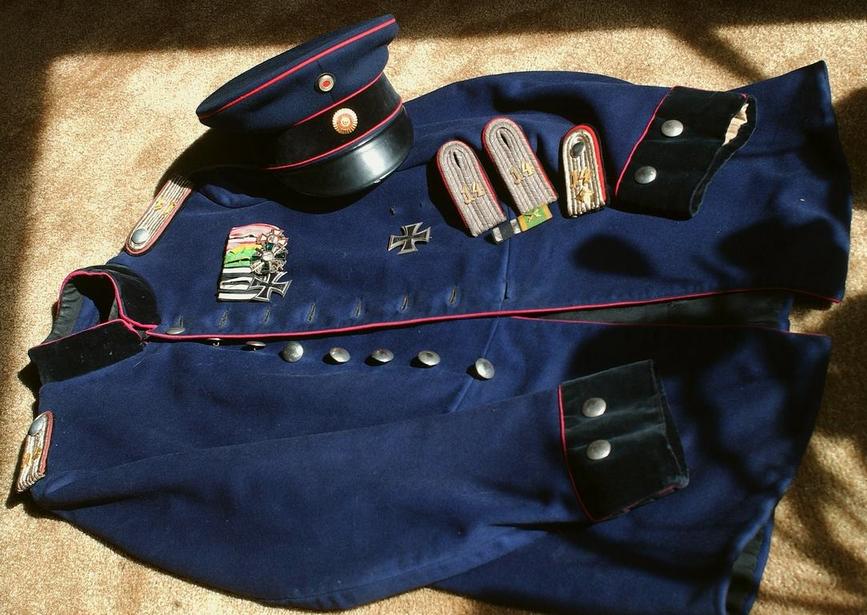
Beautiful uniform!! Absolutely outstanding!
0 -
After reading more and more personal accounts of WWI, I cannot believe what these men endured in regards to heavy, sustained, high caliber shell fire. I am surprised so many men lived through such torment, both physically and with their sanity intact.
Thanks for posting these guys! It really does make what we collect "real" doesnt it?
0 -
Great set Chris!! Was he taken out of the fighting due to his wound?
0 -
beautiful! The worksmanship on these is just fantastic. Each flintlock I have held is its own original piece, it is amazing the craftmanship that went into them.
That is a heck of a way to start a collection!! :cheers:
0 -
Very nice!! Thank you for showing those Red Eagles. A beautiful medal!
0 -
I have not collected III Reich in a while, but does the paint "trail" on the rear skirt given anyone else a bad feeling? I've seen some great German WWII helmets, but I never remember a paint run like that. That would make me wonder when it was applied honestly.
I would be interested to see what the helmet guys think
0 -
Hi Chris! The "A" is the Thrid Army patch. Units on occupation duty in Germany were allowed to sew the Third Army patch upon their uniforms. I am not quite sure the regulation for the double patch, or when it was authorized. You will see Enlisted men's uniforms double patched with either a small "A" (like CPL Younce) or a large "A" like the 126th CPT uniform below. I found it neat that Younce sewed his discharge stripe upside-down to accomodate the "A" :)
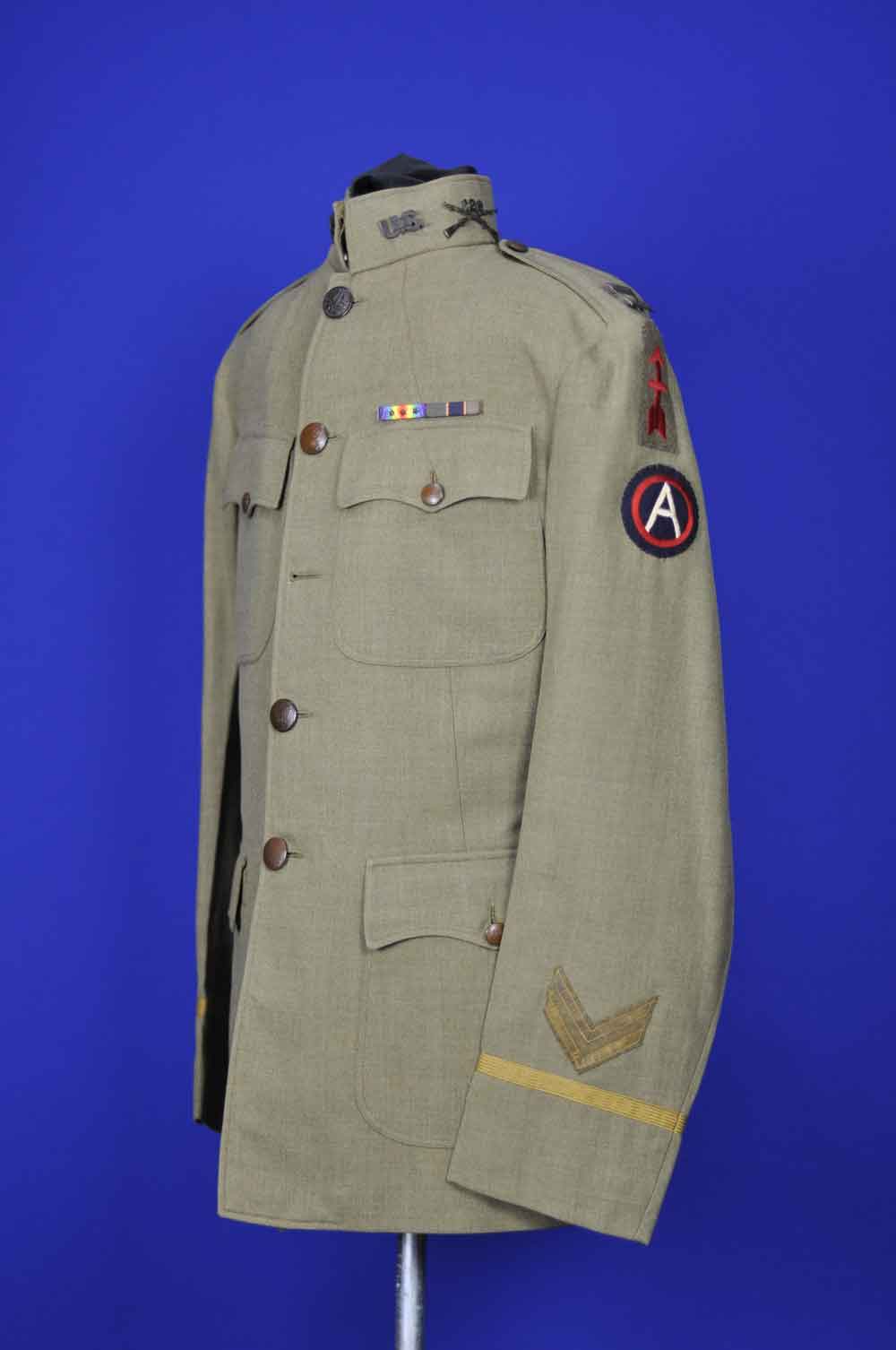 0
0 -
AWESOME Chris!
How do you remove the powder from them?
0 -
Uniform, cap, squadron pin to 1LT Bill Doran. Bill was assigned to the 99th Aero Squadron flying Salmson 2A2's during the war. He was at one point, withdrawn from the squadron to Corps level along with 3 other pilot/observer teams from teh 99th, and 4 pilots from the 104th Aero Squadron. These pilots were assigned to the 37 division for recon of their sector during the Argonne offensive. This detachment was, as far as I can tell, then assigned to the 32nd and 3rd Division's sectors for the remainder of the battle.
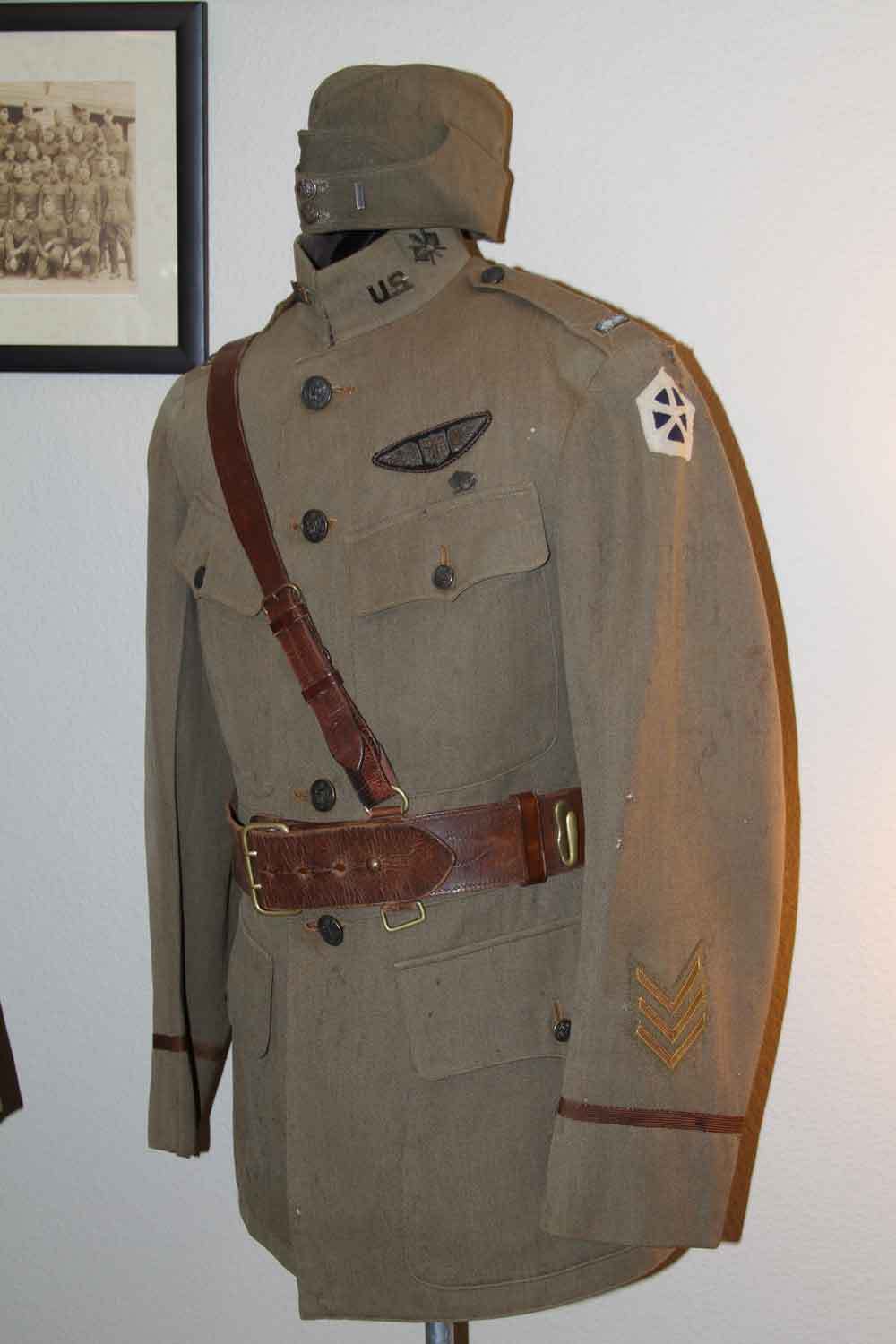 0
0 -
Tunic of Cpl Younce, E Battery, 322 artillery (Independantly attached to the 32nd division)
 0
0 -
Trench Mortar Tunic, 32nd Division
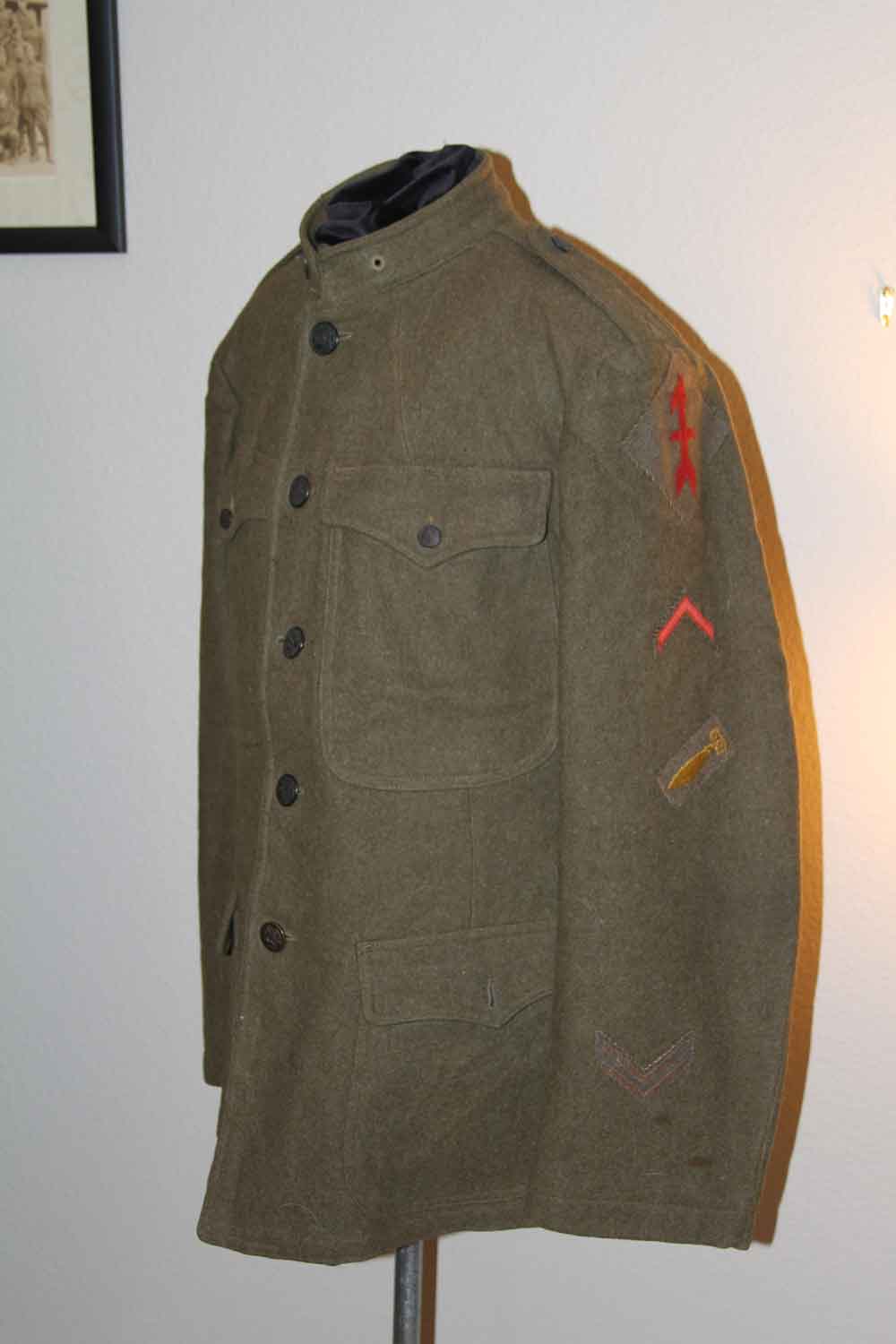 0
0 -
I cant believe this posting has not taken off. Seriously where is everyone

Tunic of Major Amos Ashley. Ordance Officer, HQ, 32nd Division (all campaigns)
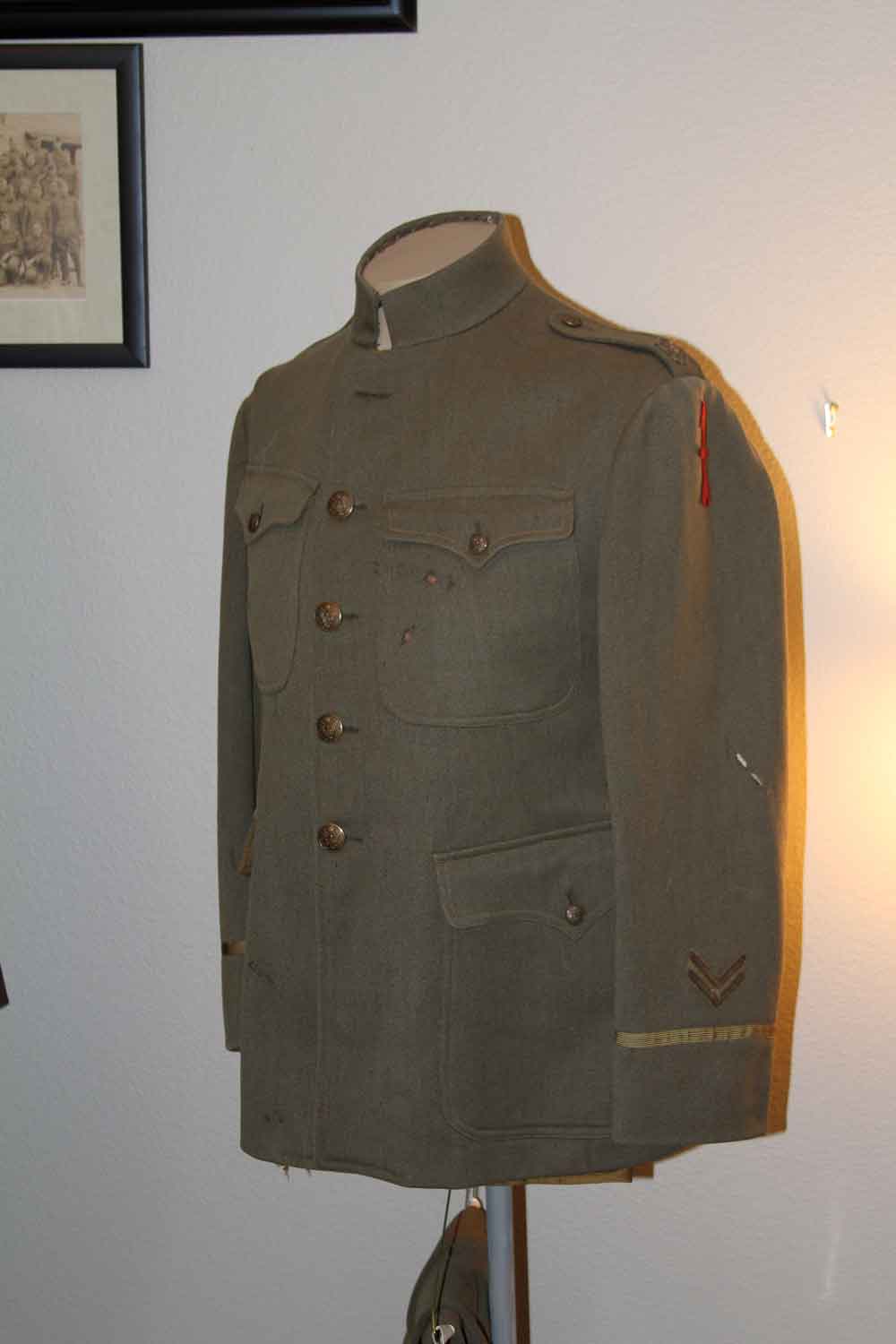 0
0 -
US Armor.
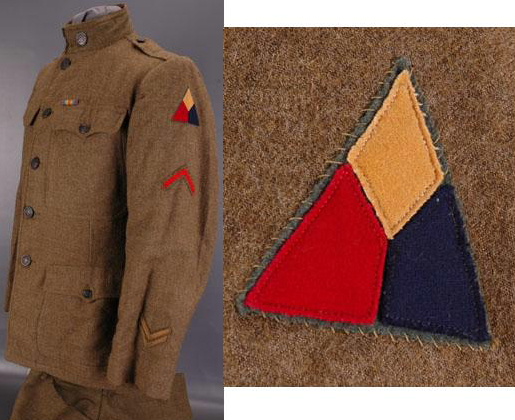
oooo nice patch! What kind of disks does your tunic have? 1st or 2nd type??
0 -
Very nice guys and well displayed! Chris thanks for showing the named German tunics with the history. I have found that on this side of the pond, obtaining a german Dunkelblau or Field-grey tunic with a history is darn near impossible. Thanks a ton for showing these.
I was going to post some but the forum was down yesterday, I will post mine this weekend.
Do we want just Army types, or do we want to show air service as well?
0 -
Actually the initial deployment to the Argonne went fairly smoothly. The Americans got nine divisions in from the German positions without General Gallwitz even taking much notice. It was after the main attack that the entire logistics system broke down. The road supplying the troops in the Argonne became a total and complete traffic jam, with troops unable to maintain contact with support units. What always stuns me in this battle, is the American general staff didn’t seem to realize they would need a route for reinforcements and supply once the fighting began. It is interesting to note that the US 32nd After action report of 4 October details that American air recognizance (given by a detachment from the 99th Aero Squadron) was used to find the 32nd Division’s own artillery!! They had become separated and stuck on the route of march due to the traffic jam leading to the Argonne.
Foch was right in being pessimistic about Pershing’s attack; although I think it was Clemenceau that really became furious with American progress. His getting stuck on the route of advance, making him unable to visit the front lines of the 35th division was a real stinker for the Americans to deal with.
I believe Pershing really believed what he was doing was right. You can find his opinions echoed in so many other brigade and battalion commanders during the beginning of, and end of the war. What surprises me is the amount of literature devoted to protecting and defending guys like Pershing and for the extent, Billy Mitchell. American tactics at Belleau Wood were a foreshadow of things to come. At least at Belleau Wood we deployed divisions with a fair number of veteran (not combat but at least trained appropriately) troops; in phase one of the Argonne six of nine units were green national guard regiments that had been amalgamated from their original structure. How they were even able to advance with rudimentary training in field operations is beyond me.
Les brings up a GREAT idea, one that has been actually floating around in my head for some time. Would there be any interest in starting a America in World War I thread, or at least a beginnings of American involvement thread? In my personal opinion, Woodrow Wilson ranks as one of the WORST presidents in American history. America should never have been involved in World War I, and should have actually ended the war soon after Verdun in 1916. Our “neutrality” was a joke and I believe, caused the war to drag on for two more years (and illegally stripped thousands of Americans of their civil liberties by giving in to British propaganda)
0 -
These are awesome! Thanks for posting Chris. I have one coming from the 127th Infantry and a copy of one to the 126th. I will post those. Very nice documents. I am on the hunt for one to one of my pilots shot down over Cambrai in 1918.
0 -
Pershing was a great military/political general, much like Eisenhower during WWII. Pershings idea to have a separate AEF was the right decision for the fledgling American Army. I shudder to think of what would happen if American Doughboys would have been assigned to General Mangins armies. He would have used them as cannon fodder to spare French casualties. So in essence I think Pershing had the right idea at an Army level. However in terms of tactics, he was woefully ignorant of modern warfare.
Pershing and the majority of the general staff believed the Europeans suffered from a lack of both nerve and forethought. Tactical American doctrine pre 1910 emphasized fire and maneuver tactics. American Generals seem to have forgotten this in 1917. In our rush to get an army in the field, America went back to what most generals knew, the rifleman. Generals like Summerall (1st Division) grew up in small brushfire wars in the Philippines and Haiti, they didnt have the experience that European generals had with massed artillery and machineguns. Training of the AEF, except for certain divisions, was poor. National Guard units, like the 37th, paid a heavy price in the Argonne for their lack of training and experience. Their training on Machineguns was, the easiest way to take machineguns, is to take them (ie with the bayonet) . It is sad that America learned nothing from the Somme and Verdun. The bayonet equipped rifleman was our answer to gas, massed artillery, and machineguns in 1918.
The Marine attack at Belleau Wood was a huge cluster. The Marines of that battle deserve every laurel given to them as their were sent into battle as sheep to the slaughter. Army troops from the 2nd division stated the Marines looked like they were on parade as they charged into the machinegun fire of the Germans. Little, if any good artillery or gas perpetration was given. It honestly could have been a reenactment of a French attack during plan XVII in 1914. The bravery of the Marines and Army troops is the only reason America didnt get embarrassed in our first major operation in WWI. Casualties were very disproportionate to what we achieved against a second rate defense.
Sadly this would be repeated again, and again by American arms until Hunter Liggett took command in the Argonne. Summerall, Patton, and Pershing learned nothing in the months preceding the Argonne offensive. The battle of Belleau Wood should have shown the American Army what fixed machineguns could do, and should have spared units like the 91st division their massive casualties at Gesnes. Sadly, the American Doughboy had to learn quickly how to survive in the trenches. America should not have been involved in WWI (another discussion), but when we arrived, we should have been ready. Artillery, gas, machineguns, and BAR assault rifles all should have been used to maximum efficiency, as American had three years of war to study.
0






Patched WW1 jacket question...
in United States of America
Posted
Hi Dan! Very nice to meet you! Frank was in the 107th Sanitary Train of the 32nd Division during the war. He was a wagoner and most likely spent a lot of time with horses drawing supplies to the front lines/medical choke points. I dont have much of Frank's history in the war yet, but I have been writing the Wisconsin Vetran's Museum to find out more. Does your family still live in Wisconsin?